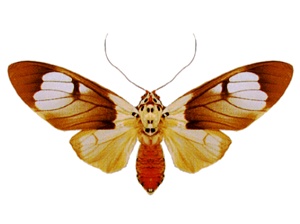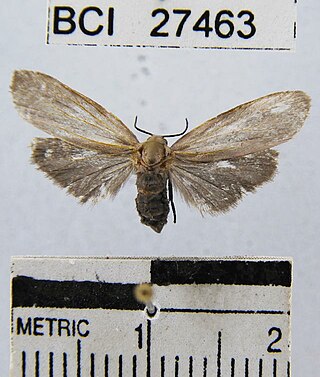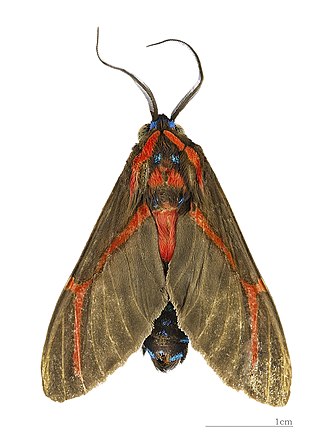
The Pterophoridae or plume moths are a family of Lepidoptera with unusually modified wings. Though they belong to the Apoditrysia like the larger moths and the butterflies, unlike these they are tiny and were formerly included among the assemblage called "microlepidoptera".

The Lymantriinae are a subfamily of moths of the family Erebidae. The taxon was erected by George Hampson in 1893.

Nepticulidae is a family of very small moths with a worldwide distribution. They are characterised by eyecaps over the eyes. These pigmy moths or midget moths, as they are commonly known, include the smallest of all living moths, with a wingspan that can be as little as 3 mm in the case of the European pigmy sorrel moth, but more usually 3.5–10 mm. The wings of adult moths are narrow and lanceolate, sometimes with metallic markings, and with the venation very simplified compared to most other moths.

Copromorphidae, the "tropical fruitworm moths", is a family of insects in the lepidopteran order. These moths have broad, rounded forewings, and well-camouflaged scale patterns. Unlike Carposinidae the mouthparts include "labial palps" with the second rather than third segment the longest. With other unusual structural characteristics of the caterpillar and adult, it could represent the sister lineage of all other extant members of this superfamily. The genus Sisyroxena from Madagascar is also notable for its unusual venation and wing scale sockets.

The Spilosomina are a subtribe of tiger moths in the tribe Arctiini, which is part of the family Erebidae.

Amerila is a genus of moths in the subfamily Arctiinae. A number of species in this genus have a special defence mechanism when they are in their adult stage. When disturbed, they exude a frothy yellow fluid from glands beside the eyes, while making a sizzling noise to ward off their attacker. Similar behaviour has been observed in fertilised females of the North-American moth Utetheisa ornatrix.
Apeplopoda is a genus of tiger moths in the family Erebidae. The genus was erected by Watson in 1980.
Aphra is a genus of moths in the subfamily Arctiinae. The genus was described by Watson in 1980.

Clystea is a genus of moths in the subfamily Arctiinae. The genus was described by Watson in 1980.
Euchlorostola is a genus of moths in the subfamily Arctiinae. The genus was described by Watson in 1980.

Euthyone is a genus of moths in the subfamily Arctiinae. The genus was erected by Watson, Fletcher and Nye in 1980.

Halysidota is a genus of moths in the family Erebidae. The genus was erected by Jacob Hübner in 1819.

Himerarctia is a genus of moths in the family Erebidae. The genus was described by Watson in 1975.
Hobapromea is a monotypic moth genus in the subfamily Arctiinae described by Watson in 1980. Its single species, Hobapromea cleta, was first described by Turner in 1940. It is found in Queensland, Australia.
Micragrella is a genus of moths in the subfamily Arctiinae. The genus was erected by Watson in 1980.

Olepa is a genus of moths in the family Erebidae. The genus was described by Watson in 1980. Most part of species occur in India and Sri Lanka, though one species was described from Israel.
Paralpenus is a genus of moths in the subfamily Arctiinae from the Afrotropics. The genus was described by Watson in 1988.
Trocodima is a genus of moths in the family Erebidae. The genus was described by Watson in 1980.

Ithonidae, commonly called moth lacewings and giant lacewings, is a small family of winged insects of the insect order Neuroptera. The family contains a total of ten living genera, and over a dozen extinct genera described from fossils. The modern Ithonids have a notably disjunct distribution, while the extinct genera had a more global range. The family is considered one of the most primitive living neuropteran families. The family has been expanded twice, first to include the genus Rapisma, formerly placed in the monotypic family Rapismatidae, and then in 2010 to include the genera that had been placed into the family Polystoechotidae. Both Rapismatidae and Polystoechotidae have been shown to nest into Ithonidae sensu lato. The larvae of ithonids are grub-like, subterranean and likely phytophagous.

Apocordulia is a genus of dragonflies in the family Austrocorduliidae, endemic to the Murray-Darling Basin in eastern Australia.












